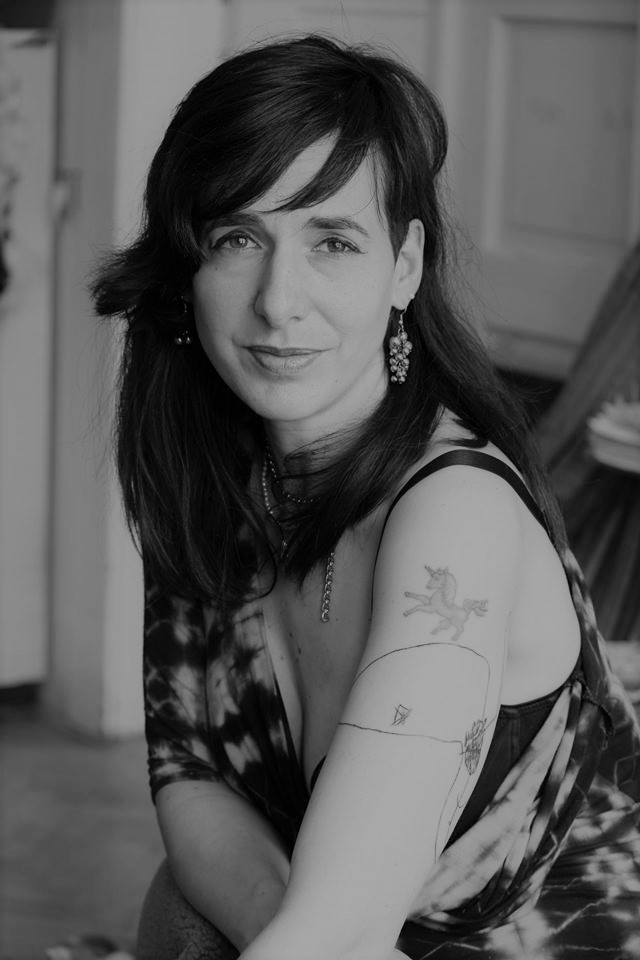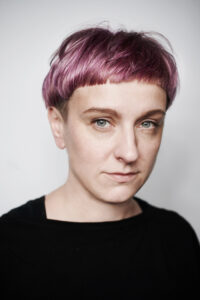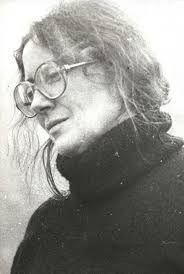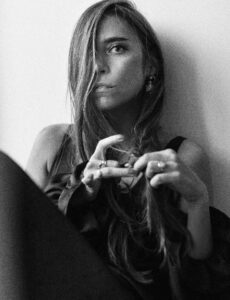Darina Alster

– born 1979 – a visual artist. In 2016 she and Kateřina Olivová established a support group for women artists who have children named Mothers Artlovers. They also run the studio for New Media II at the Academy of Fine Arts in Prague together. Darina does group performances, post-performance, interactive installations. She works with themes relating to personal bodily boundaries, identity, sexuality, spirituality, which she explores from a standpoint of post-humanism, feminism and deep ecology. From 2019 she togehter with Kateřina Olivová running New Media 2 studio in Academy of Fine Arts Prague.
Poke the trigger points that move society
Performance has become a very broad platform in recent times for communicating political themes in society. Although I am very interested in political art and I think that in a sense all art is political, it is still important for me to maintain my status as an artist in my projects. Instead of clear political agitation in the form of performance, I try to offer an atypical approach to the given issue.
In the framework of performance, the hermetic aspect of creativity is important to me, along with a certain playfulness working with imagination and spirituality. In group performances, I create an autonomous zone (safe space), and, against this backdrop, attempt to build an alternative model of the world, in which different structures of experience might function – other possibilities for relationships between humans and between species. In a certain way, performance is an act in which one finds oneself outside the realm of rationality, and, in this utopian reality, can look upon and experience the world differently, finding solutions in places where our rational ways of thinking normally limit us1234.
My performances are not scripted, but all embrace a simple rule. It is critical for me to create a certain mental field. Participants in the performance should remain mentally present. A preparatory ritual takes place before the actual performance, for days or weeks leading up to it. And in the work itself I draw from spiritual traditions: Hermeticism, Christianity56, mystical Islam, Zen tantra and feminist Buddhism. I use Tarot78 – the symbolism of the Kabbalistic tree of life, or classic Pentagram and Hexagram rituals, which are traditional methods from which I elicit certain systems for use in my work. This year, I performed the Nonbinary Madonna at the recently re-erected Marian Column on the Old Town Square in Prague. On the one hand, it was a critique of the Czech Catholic Church’s current interests and the power disputes that had arisen around the column’s erection; on the other, it was a tribute to the activists of the contemporary environmental and queer movements, from whose bodies the Nonbinary Madonna is formed. The event had a strong ritual character, with the intention of modernizing the archetype of the Madonna, consecrating the column using a traditional Catholic liturgy, this time performed by women910.
Both my personal relationship and society’s relationship to feminism has certainly fundamentally changed during my work. Upon graduating from the Academy of Fine Arts in 2005 a piece of my work on the theme of sexuality and religion was removed from my final exam exhibition. I have always had an issue with my own identity. I often felt more like a “they” than “he” or “she.” At that time I had a partnership with a man and a woman. Now I know that that is called polyamory and the sexual orientation is called bisexuality, but I didn’t know that then and, even though the art scene acted as though it was very open, in reality it was not very free-thinking. Maintaining one’s own position was quite difficult. Taking on the theme of sexuality in my art was very natural. I needed to designate certain positions in having diverted from traditional norms of social behavior11.
For my feminism, meeting the translator and famous rocker Pavla Jonsson was a shaping force. As a member of the punk bands Dybbuk a Zuby nehty she had been my girlhood idol, and later, when I was around 25, she introduced me to feminism. It occurred to me then that I had already been working with feminist themes for a long time, I just didn’t know it. Motherhood has given me the biggest impulse to feminism12. When Kateřina Olivová and I established a support group for mother-artists in Prague and Brno in 2016, artists were overwhelmingly interested. The group’s aim is to enable artists who are mothers to stay in touch with the art world through their maternal journey. At the same time, Mothers Artlovers is based on non-hierarchical participatory projects, which we also use to criticize institutions131415.
In comparison with my generation, the younger artists are quite a bit more involved in social issues. In our studio NM2 at the Academy of Fine Arts, we try to name these themes, work with the imagination and perceive art not as a commodity but as a tool for social change. We work with themes of care, mental hygiene, personal resistance, sustainability, embodiment, and personal questions around feminism and ecology. This semester our studio has the theme of sharing emotions through the internet – overcoming the distance encountered in online communication. We try to foster the awareness in our students that their work, even at the beginning of their career, has the power to influence the art scene.
This text was written in cooperation with Marianna Placáková (2020).
1Darina Alster, Desire is all that exists!, 2019, Festival nahých foriem [Festival of naked forms],Prague.2Darina Alster, Jana Orlová, Theatrum Mundi 1.0, 2016, Karlin Studios, Prague.
3Image: Darina Alster, 24h Performance, 2020, Ferdinand Baumann Gallery, Prague. Courtesy of the artist.
4Image: Darina Alster, 24h Performance, 2020, Ferdinand Baumann Gallery, Prague. Courtesy of the artist.
5Darina Alster, Imago Dei, 2013, see: https://www.artwallgallery.cz/en/exhibition/darina-alster-imago-dei.
6Darina Alster. Naked Lunch, 2009, galerie etc, Prague.
7Darina Alster, Personal Tarot Mobiles, 2008, The Prague Contemporary Art Festival.
8Adam Borzič, Tarotová kancelář Dariny Alster [Tarot Office of Darina Alster],[in:] "Ateliér", 2009 (22), n. 14-15, p. 6.
9Image: Darina Alster, Nebinárni Madona [The non-binary Madonna], 2020, see: https://wave.rozhlas.cz/mariansky-sloup-je-nas-rika-feministicka-performerka-darina-alster-8322618.Courtesy of the artist.
10Image: Darina Alster, Nebinárni Madona [The non-binary Madonna], 2020, see: https://wave.rozhlas.cz/mariansky-sloup-je-nas-rika-feministicka-performerka-darina-alster-8322618.Courtesy of the artist.
11Magdaléna Šipka, Nikolai Ivaschiv, Interview with Darina Alster,[in:]"Studio", 2014, grade. 27, n. 2324, p. 5.
12Darina Alster, Laktační umění [Lactation art], 2013, sam83 Gallery, Česká bříza.
13Studio Mothers Artlovers, see: https://mothersartlovers.tumblr.com/.
14See: https://wave.rozhlas.cz/automatky-o-umeni-materska-revoluce-s-mothers-artlovers-5960066.
15See: https://vltava.rozhlas.cz/atelier-mothers-artlovers-patriarchat-je-tak-zazrany-ze-zmeny-nejde-delat-rychle-8287956.
– narozena 1979 – vizuální umělkyně, v roce 2016 založila společně s Kateřinou Olivovou podpůrnou skupinu pro matky-umělkyně Mothers Artlovers, v současnosti vede také společně s Kateřinou Olivovou Ateliér nových médií II na Akademii výtvarných umění v Praze, zabývá se skupinovými performancemi, post-performancí, interaktivními instalacemi, ve své tvorbě zpracovává témata související s osobními hranicemi těla, identitou, sexualitou, spiritualitou, jež zkoumá z post-humanistických feministických a hlubinně ekologických pozic. Od roku 2019 vede společně s Kateřinou Olivovou ateliér Nová média 2 na Akademii výtvarných umění v Praze.
/darinaalster.org/ /darinaalster.tumblr.com/
Dotýkat se neuralgických bodů, které hýbou společností
Performance se v poslední době stala velmi rozšířeným způsobem, jak komunikovat politická témata ve společnosti. Ačkoli mě politické umění hodně zajímá a myslím si, že v určitém smyslu je všechno umění politické, je pro mě důležité uchovat si při svých projektech status umělkyně. Na rozdíl od jasně politicky agitačních forem performancí se ve svých projektech snažím nabídnout netypický přístup k dané problematice. Důležitý je pro mne hermetický aspekt tvorby, určitá hravost v práci s imaginací a spiritualitou v rámci performance. Ve skupinových performancích vytvářím autonomní zónu (safe space) a na jejím pozadí se pokouším vybudovat alternativní model světa, v němž by fungovaly jiné struktury prožívání a možnosti mezilidských i mezidruhových vztahů. V určitém smyslu je to akt, kdy se člověk ocitne mimo racionalitu a v této utopické realitě může nahlížet a prožívat svět jinak a nacházet řešení tam, kde nás racionální uvažování za normálních okolností omezuje1234.
Moje performance nemají žádný scénář, ale existují pro ně jednoduchá pravidla. Důležité je pro mě vytvoření určitého mentálního pole. Jednotliví účastníci a účastnice by měli být během performance mentálně v přítomnosti. Samotnému aktu dále předchází rituální práce, kterou se na performance několik dnů i týdnů připravuji. V práci zároveň vycházím ze spirituálních tradic hermetismu, křesťanské56 a islámské mystiky, zenové tantry, nebo feministických proudů buddhismu. Používám tarot78, symboliku kabalistického stromu života, nebo klasických pentagramových a hexagramových rituálů, což jsou tradiční metody, ze kterých pro svoji práci čerpám určité systémy. Letos jsem uspořádala performance Nebinární Madona u nedávno vztyčeného Mariánského sloupu na Staroměstském náměstí v Praze. Na jedné straně šlo o kritiku současných zájmů české katolické církve a mocenských sporů, které kolem jeho obnovení nastaly. Zároveň se jednalo o poctu aktivistkám a aktivistům současných ekologických a queer hnutí, z jejichž těl je Nebinární Madona utvořena. Akce měla silně rituální charakter, jehož záměrem byla aktualizace archetypu Madony skrze tradiční katolickou liturgii svěcení, performovanou ženami910.
Můj osobní vztah i vztah české společnosti k feminismu se určitě během mé umělecké praxe zásadně proměnil. Po roce 2005, kdy jsem dostudovávala Akademii výtvarných umění v Praze, mi ještě z klauzur sundávali díla, v nichž jsem řešila sexualitu společně s náboženstvím. Sama jsem odjakživa měla problémy s vlastní identitou. Cítila jsem se vždy spíš jako my, než jako on nebo ona. Stejně tak jsem tehdy měla partnerský vztah s ženou a mužem. Dnes vím, že se to nazývá polyamorie a sexuální orientace bisexualita, ale tehdy jsem to nevěděla a i když se umělecké prostředí tvářilo velmi otevřeně, ve skutečnosti tak svobodomyslné nebylo. Udržet si vlastní pozici bylo dost náročné. To, že jsem se v tvorbě začala zabývat sexualitou, pro mě tedy vyplynulo naprosto přirozeně. Potřebovala jsem si pojmenovat určité pozice kvůli tomu, že jsem vybočovala z klasických norem společenského chování11.
Pro můj feminismus bylo klíčové poznat se s překladatelkou a slavnou rockerkou Pavlou Johnsson. Jako členka punkových dívčích kapel Dybbuk a Zuby nehty pro mě byla dívčím idolem, později, kolem mých 25 let mě přivedla k feminismu a mně tehdy došlo, že se vlastně už dávno zabývám feministickými tématy, jen jsem je tak do té doby nepojmenovávala. Největší feministku ze mě udělalo mateřství12. Když jsme s Kateřinou Olivovou v roce 2016 založily podpůrnou skupinu pro matky umělkyně v Praze a Brně, byl o ní obrovský zájem ze strany umělkyň. Jejím cílem je umožnit umělkyním zůstat přes své mateřství v kontaktu se světem umění. Zároveň s Mothers Artlovers vytváříme nehierarchické participativní projekty, které fungují i jako institucionální kritika131415.
Nejmladší umělecká generace se ve srovnání s mou generací zajímá o dost více o společenské otázky. V našem ateliéru NM2 na AVU se snažíme tato témata pojmenovávat, pracovat s imaginací a chápat umění ne jako komoditu ale jako nástroj společenských změn. Zabýváme se tématy péče, sebehygieny, osobní rezistence, udržitelnosti, tělesnosti a obecnějšími otázky feminismu a ekologie. Jako ateliérové téma máme tento semestr sdílení emocí přes internet – překonání pocitu vzdálenosti, na níž se online komunikace podílí. Snažíme se ve studentech a studentkách budovat vědomí toho, že již od úplných počátků své tvorby mají moc uměleckou scénu ovlivňovat.
Text vznikl ve spolupráci s Mariannou Placákovou (2020).
1Darina Alster, Desire is all that exists!, 2019, Festival nahých forem, Praha.2Darina Alster, Jana Orlová, Theatrum Mundi 1.0, 2016, Karlin Studios, Praha.
3Obrázek: Darina Alster, 24h Performance, 2020, Galerie Ferdinanda Baumanna, Praha. S laskavým svolením umělkyně.
4Obrázek: Darina Alster, 24h Performance, 2020, Galerie Ferdinanda Baumanna, Praha. S laskavým svolením umělkyně.
5Darina Alster, Imago Dei, 2013, viz: https://www.artwallgallery.cz/en/exhibition/darina-alster-imago-dei.
6Darina Alster, Naked Lunch, 2009, galerie etc, Praha.
7Darina Alster, Personal Tarot Mobiles, 2008, The Prague Contemporary Art Festival.
8Adam Borzič, Tarotová kancelář Dariny Alster, [v:] "Ateliér", 2009 (22), č. 14-15, s. 6.
9Obrázek: Darina Alster, Nebinární madona, 2020, viz: https://wave.rozhlas.cz/mariansky-sloup-je-nas-rika-feministicka-performerka-darina-alster-8322618. S laskavým svolením umělkyně.
10Obrázek: Darina Alster, Nebinární madona, 2020, viz: https://wave.rozhlas.cz/mariansky-sloup-je-nas-rika-feministicka-performerka-darina-alster-8322618. S laskavým svolením umělkyně.
11Magdaléna Šipka, Nikolai Ivaschiv, Rozhovor s Darinou Alster, [v:] "Ateliér", 2014 (27), č. 2324, s. 5.
12Darina Alster, Laktační umění, 2013, galerie sam83, Česká bříza.
13Ateliér Mothers Artlovers, viz: https://mothersartlovers.tumblr.com/.
14Viz: https://wave.rozhlas.cz/automatky-o-umeni-materska-revoluce-s-mothers-artlovers-5960066.
15Viz: https://vltava.rozhlas.cz/atelier-mothers-artlovers-patriarchat-je-tak-zazrany-ze-zmeny-nejde-delat-rychle-8287956.


